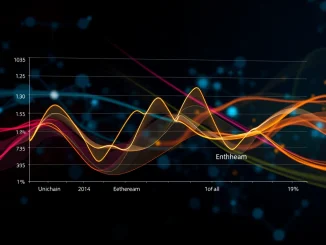
In the fast-paced and often turbulent world of cryptocurrency, trust and transparency are paramount. Recently, the Mantra project and its native OM token have faced market headwinds, sparking concerns among investors. Amidst swirling rumors and price fluctuations, Mantra CEO John Mullin has stepped forward to set the record straight. His message is clear: OM token recovery is not just a priority, it’s the top priority. Let’s dive into Mullin’s statements and understand the path forward for OM.
Mantra CEO Prioritizes OM Token Recovery: A Deep Dive into the Plan
Addressing the community directly, Mantra CEO John Mullin emphasized the unwavering commitment to revitalizing the OM token. In a move to reassure holders and the wider crypto market, Mullin outlined several key strategies under consideration to bolster the token’s value and stability. These strategies are not just words on paper; they represent concrete actions aimed at injecting strength back into the OM ecosystem.
- Buybacks: One of the most direct methods to increase token value is through strategic buybacks. By purchasing OM tokens from the open market, Mantra aims to reduce the circulating supply, which can, in turn, drive up demand and price. This demonstrates a clear investment in the token’s future.
- Burns: Token burning is another powerful mechanism to reduce supply permanently. When tokens are burned, they are effectively removed from circulation forever. This scarcity tactic can have a significant positive impact on the remaining tokens’ value.
- Transparency Report: To underscore Mantra’s commitment to openness, Mullin pointed to a transparency report. This report is likely to detail token distribution, holdings, and project activities, aiming to build trust and dispel misinformation.
- Ecosystem Fund Support: Reinforcing the recovery efforts, Mullin highlighted the $109 million Ecosystem Fund. This substantial fund is dedicated to supporting the project’s growth and, crucially, its recovery. It signals long-term commitment and resources allocated to navigate current challenges.
These measures collectively paint a picture of proactive management and a serious dedication to the OM token recovery. But what about the whispers of insider activity?
Debunking Crypto Insider Selling: Setting the Record Straight on OM Token Transactions
In the often opaque world of crypto, accusations of insider selling can quickly erode trust and trigger panic. Mantra has faced such allegations, with concerns arising about significant token movements. CEO John Mullin directly addressed these rumors, vehemently denying any insider dumping of OM tokens. His defense rests on several key points:
- 90% Control Claim: Mullin asserted that Mantra itself controls a staggering 90% of the total OM token supply. This claim, if accurate, significantly limits the scope for large-scale insider selling by individuals outside of Mantra’s direct control. He urged the community to refer to the transparency report for verification of these holdings.
- Major Exchange Holdings: To further illustrate the distribution of OM tokens, Mullin identified major cryptocurrency exchanges Binance and OKX as significant holders. This suggests that large portions of the token supply are held in publicly known and regulated entities, rather than obscure wallets potentially linked to insiders.
- Binance Staking Program Clarification: A key point of contention was a transfer of 38 million OM tokens. Mullin clarified that this transfer was not a sell-off but was directly linked to the completion of a Binance staking program. Staking programs involve temporarily locking up tokens to support network operations, and their conclusion naturally leads to the return of these tokens to their owners. This explanation aims to demystify a transaction that might have been misconstrued as a sale.
By directly addressing the crypto insider selling allegations and providing concrete explanations, Mullin is attempting to rebuild confidence and demonstrate that recent token movements are not indicative of malicious activity.
Understanding the Binance Staking Program Transfer: Transparency in Token Movement
The 38 million OM token transfer deserves a closer look, as it became a focal point of speculation. Understanding the context of the Binance staking program is crucial to interpreting this transaction correctly. Let’s break down why this transfer is presented as a normal operational event rather than a suspicious sell-off:
| Aspect | Explanation |
|---|---|
| Staking Program Nature | Binance, like many exchanges, offers staking programs that allow users to earn rewards by locking up their crypto assets. These programs are legitimate and widely used in the crypto space. |
| Temporary Token Lock-up | When users participate in staking, their tokens are temporarily locked up for a predetermined period. This is a standard mechanism to support network security and operations. |
| Program Completion | Staking programs have defined durations. Upon completion, the staked tokens, along with any earned rewards, are automatically returned to the participants or the entity that initiated the staking. |
| 38 Million OM Transfer | Mullin clarifies that the 38 million OM transfer was precisely the return of tokens from a completed Binance staking program. It was a pre-planned event tied to the program’s end, not a sudden or secretive sell-off. |
By providing this context, Mantra aims to demonstrate that the 38 million OM transfer was a transparent and expected event within the normal course of operations related to the Binance staking program, and not evidence of nefarious insider actions.
Navigating OM Token Volatility and Exchange Liquidations: Addressing Market Fluctuations
The cryptocurrency market is known for its inherent volatility, and the OM token has not been immune to recent fluctuations. Mullin acknowledged that recent price swings were partly attributable to OM token volatility stemming from exchange liquidations. Understanding how liquidations impact token prices is essential.
- Liquidation Cascade: In leveraged trading, exchanges can liquidate positions when the collateral value falls below a certain threshold. In times of market downturn, this can trigger a cascade effect, where liquidations lead to further price drops, prompting more liquidations.
- Exchange-Driven Volatility: When OM was liquidated as collateral on an exchange, it introduced a sudden influx of tokens into the market, putting downward pressure on the price. This is a common source of short-term volatility in crypto markets.
- Market Sentiment Impact: Exchange liquidations can also negatively impact market sentiment. They can create a perception of panic or instability, leading to further selling pressure, even from holders who were not directly involved in leveraged trading.
While OM token volatility driven by liquidations can be concerning, it’s important to recognize that it’s often a broader market phenomenon and not necessarily indicative of fundamental problems with the project itself. Mantra’s focus on recovery efforts aims to build resilience against such market pressures.
The Role of the Ecosystem Fund in Mantra CEO’s Recovery Strategy: Fueling Future Growth
The $109 million Ecosystem Fund stands as a powerful testament to Mantra’s long-term vision and commitment to Mantra CEO John Mullin’s recovery strategy. This significant financial resource is not just a symbolic gesture; it’s a strategic tool designed to fuel the project’s resurgence and future growth.
The Ecosystem Fund is intended to be deployed across various initiatives, all aimed at strengthening the OM ecosystem. These may include:
- Development and Innovation: Funding new features, upgrades, and technological advancements for the Mantra platform and OM token.
- Community Growth: Supporting initiatives to expand the Mantra community, attract new users, and foster engagement.
- Strategic Partnerships: Investing in collaborations and partnerships that can broaden the reach and utility of OM.
- Marketing and Awareness: Allocating resources to enhance marketing efforts and increase awareness of Mantra and OM in the wider crypto space.
- Recovery Initiatives: Potentially using portions of the fund for buybacks and burns, directly supporting the token’s price and stability.
The existence of this substantial fund provides Mantra with the financial firepower to weather current storms and invest strategically in its future. It signals to the community that recovery is not just a verbal commitment but is backed by significant resources under the leadership of Mantra CEO John Mullin.
Conclusion: A Path to Recovery and Renewed Trust for OM Token
Mantra CEO John Mullin’s proactive communication and outlined recovery plan represent a crucial step towards rebuilding trust and confidence in the OM token. By directly addressing concerns about insider selling, clarifying token transfers, and emphasizing the commitment to buybacks and burns, Mantra is taking tangible steps to stabilize and revitalize the OM ecosystem. The $109 million Ecosystem Fund provides further assurance of long-term commitment and resources dedicated to growth. While the crypto market remains volatile, Mantra’s transparent approach and concrete recovery strategies offer a beacon of hope for the OM token and its community. The journey to full recovery may take time, but the foundations for a strong comeback are being laid.



